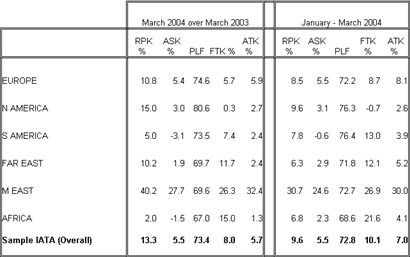"Travel and tourism share a common future and therefore, we must also share the same goals. Together we must drive the changes needed to ensure sustainable profitability," said Bisignani. "To survive, airlines reduced their cost structure and improved efficiency. It is now time for the air transport and tourism industries to strengthen their partnership. Together we must ensure that our monopoly infrastructure providers share our drive for cost reduction and efficiency and that governments understand the need for greater liberalization."
Bisignani during his presentation in Doha released March and First Quarter results. In the first quarter of 2004, air transport posted a 9.6% improvement in passenger traffic and 10.1% growth in freight traffic over the same quarter in 2003.
March 2004 figures showed a 13.3% increase in passenger traffic and an 8.0% increase in freight traffic over March 2003. The association noted that March 2004 figures indicate exaggerated growth due to the combined negative impact of SARS and the outbreak of war in Iraq during March 2003.
Nonetheless, traffic grew in all regions, with exceptional growth recorded by Middle Eastern carriers who posted March year on year same month jumps of 40.2% and 26.3% for passenger and cargo traffic respectively. Over the first quarter, Middle Eastern carriers posted results that were no less impressive: 30.7% and 26.9% for cargo and passenger traffic respectively.
"The industry is on track to outperform our forecast of 6.9% growth in passenger volumes over 2003 levels," said Bisignani. "More importantly, the industry is showing clear signs of its ability to match capacity to demand. We are moving in the right direction, however tremendous challenges remain."
Page 2 : shows table of March 2004 Monthly International Statistics.

Notes for editors:
1. Explanation of measurements:
a. RPK: Revenue Passenger Kilometres measures actual passenger traffic
b. ASK: Available Seat Kilometres measures available passenger capacity
c. PLF: Passenger Load Factor is % of ASKs used.
d. FTK: Freight Tonne Kilometres measures actual freight traffic
e. ATK: Available Tonne Kilometres measures available total capacity (combined passenger and cargo)
2. IATA statistics cover international scheduled air traffic; domestic traffic is not included.
3. All figures are provisional and represent total reporting at time of publication plus estimates for missing data.
4. Due to uncertainties in the adoption of the new ICAO statistical definitions by reporting carriers, care should be taken when making year comparisons.
For more information:
Corporate Communications
Tel + 41 22 7702960
Corpcomms@iata.org